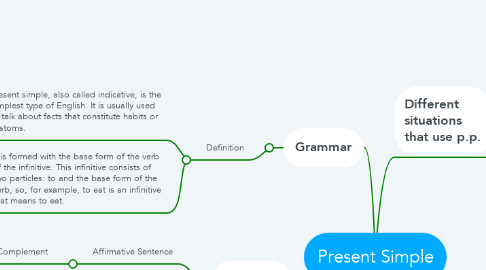
1. Grammar
1.1. Definition
1.1.1. Present simple, also called indicative, is the simplest type of English. It is usually used to talk about facts that constitute habits or customs.
1.1.2. It is formed with the base form of the verb of the infinitive. This infinitive consists of two particles: to and the base form of the verb, so, for example, to eat is an infinitive that means to eat.
2. Structure
2.1. Affirmative Sentence
2.1.1. Subject + Verb + Complement
2.2. Negative Sentence
2.2.1. Subject + Verb + Not + Complement
2.3. Interrogative Sentence
2.3.1. "To Do" + Subject+Verb + ?
3. Examples
3.1. ‘Joey never eats vegetables’.
3.1.1. The party in Monica’s house is tonight’.
3.2. The Tribbiani don’t know everything about food’.
3.2.1. Joey! Don’t be silly and eat the vegetables!’.
3.3. Does she live in France with her boyfriend?
3.3.1. Does he know about your secret?
3.3.1.1. Short answer: Yes, she does No, she doesn´t
3.3.2. Short answer: Yes, she does No, she doesn´t
